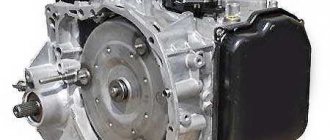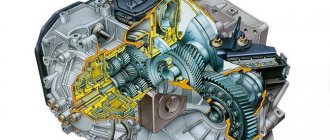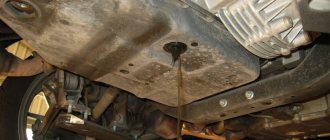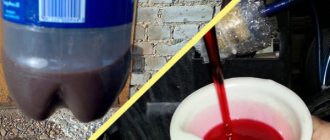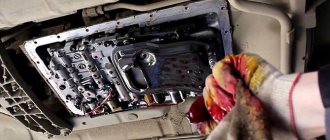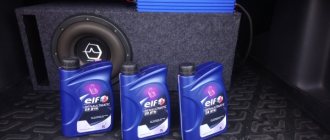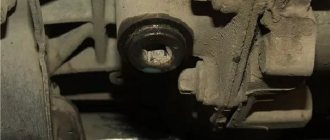Functions of transmission oil
Since an automatic transmission consists of different mechanisms: a torque converter, a planetary gear, a set of clutches, ATF oil performs several functions at once:
- Promotes smooth gear shifting, reduces noise and vibration during operation.
- Removes heat from heating parts. The average temperature in the automatic transmission crankcase is 80-90°C, but in the summer during the urban driving cycle it reaches 150°C. Oil cooling occurs in a radiator specially designated for this purpose, which is located separately or combined with the radiator of the cooling system.
- Transmits force to the control spools of the hydraulic system, ensuring gear shifts.
- Being the working fluid of the torque converter, the transmission fluid connects the engine flywheel to the planetary gear set of the automatic transmission.
- Provides a certain coefficient of friction between the friction discs at the moment of gear shifting.
How much oil is in automatic transmission
Eighth generation E110, 1997-2001
The eighth generation of Corolla has undergone minimal design changes compared to the previous model. On the other hand, the car was seriously different outside and inside. In addition, the range of options has expanded significantly, but the engine range still consists of proven gasoline engines with a volume of 1.3-2.2 liters (from 70 to 165 hp). The main sedan version had front-wheel drive, while the station wagon was offered only with 4WD and a 1.8-liter internal combustion engine. In 1999, restyling took place, bringing the VVT-I (variable valve timing) system to the engine range, which made it possible to extend the relevance of the model until 2000.
Also read: Automatic transmission oil for Kia Rio
Automatic transmission oil: volume – 7 liters with a complete change; 4 liters for partial replacement
Ninth generation E120, 2000-2006
The 10th generation Corolla is based on the shortened platform of the Toyota Vista model, intended for Japan. The family of the same name still consisted of a sedan, hatchback and station wagon. The bodies of all modifications were unified as much as possible in order to reduce the cost of production. In addition, this made it possible to improve the situation by interchangeability of spare parts in the service center. On the other hand, this had a negative impact on the design - the Corolla E120 family looked monotonous and modest compared to its closest analogues, which already offered something new in design. However, from the front the car was noticeably different from its predecessor. The car received naturally aspirated petrol engines, the most powerful of which was a 1.8 turbo with a capacity of 192 hp. With.
Automatic transmission oil: volume – 7 liters with a complete change; 4 liters for partial replacement
Tenth generation E150, 2006-2012
Starting with the 10th generation, the Corolla is only a 4-door sedan, and the hatchback became a separate model under the name Auris (the Corolla name for the hatchback was retained only for the Australian market). As for the station wagon, it was sold in Japan with a modified design and the Fielder prefix in the name. In terms of design, the car resembled a smaller 2005 Toyota Camry. The same applies to driving performance, and in this case the key advantages of the Corolla remained soft suspension, smooth ride and predictable handling. On the Russian market, the sedan was available with 1.4 and 1.6 liter gasoline engines (97-124 hp), as well as manual or “robot” engines. After restyling in 2010, it became possible to order a version with a 4-speed automatic transmission. After the release of the successor in 2012, only manual transmission or CVT remained in the list of available transmissions.
Also read: Motor oil for Toyota Cresta engine
Automatic transmission oil: volume – 7 liters with a complete change; 4 liters for partial replacement
Lubricant composition
The presence of such a range of functions determines which components should be included in the lubricant mixture. In addition to the base product (synthetic, semi-synthetic, mineral), the oil contains a package of additives that improve its properties:
- Antioxidants. High temperatures and oxygen lead to premature aging of the oil, which results in the formation of varnish deposits, resinous substances and sludge. Antioxidants neutralize them throughout the life of the oil, slowing down the aging process.
- Anti-corrosion additives. They form a protective layer on the surface of parts, preventing chemical corrosion of metals.
- Viscosity index modifiers. They improve the viscosity-temperature characteristics of the lubricant by changing the volume of high-molecular polymers of which they are composed.
- Additives that improve lubricating properties. These additives form a super-strong protective layer on friction surfaces, providing better wear protection.
- Detergent additives, dispersants. Keep wear products in suspension, preventing them from settling.
- Anti-foam additives. Designed to prevent foam formation and promote its rapid destruction by reducing the surface tension of the lubricant.
Important: Different brands of ATF have similar properties. They differ only in operational characteristics and friction indicator. It is these properties that affect the applicability of ATF in automatic transmissions of various models.
Choosing oil for automatic transmission Toyota Corolla
Before adding new oil, you must make sure that this product meets all the parameters specified in the instructions. In other words, the oil must be fully compatible with the Toyota Corolla automatic transmission. Therefore, in order to avoid mistakes in the selection process, you must rely on the manufacturer’s instructions. For example, you should only fill in original Toyota ATF Type T-IV oil. This product has optimal viscosity parameters and is designed for a long service life. As for the type of oil, in our case only synthetic is suitable. It is recommended to fill in semi-synthetic oil only with high mileage, or in case of lack of funds for expensive synthetic oil.
How often should you change ATF?
During operation, transmission fluid gradually loses its lubricating properties. This is facilitated by frequent overheating, difficult working conditions, and natural wear of friction linings and bearings.
Important: Automatic transmission oils for Toyota vehicles have optimal viscosity, which allows them to maintain their lubricating properties over a wide temperature range.
The average replacement interval for transmission fluids is 50–150 thousand km and depends on the following factors:
- quality of the oil used;
- type of gearbox (automatic, continuously variable variator, robotic);
- operating conditions (urban mode, high loads, long trips).
Under normal conditions, there is no need to change the fluid; you just need to monitor its level in the crankcase and add it if necessary. A complete replacement of the lubricant in a Toyota automatic transmission is carried out in accordance with the scheduled maintenance of a particular vehicle.
Tip: When completely replacing the lubricant, it is recommended to flush the gearbox with special flushing agents. Together with cleaning the oil channels, they restore the tightness of the seals and the operation of the satellites.
Partial or complete replacement
In the Camry 50 gearboxes, just like in the previous body equipped with the same gearboxes, the oil can be changed completely or partially.
A partial oil change in an automatic transmission is done in a simple way: as much as the old one is drained, the same amount of new oil is poured in (about 2-2.5 liters are drained).
A partial replacement is done at a mileage of 40,000 km, then the oil is partially changed after another 40,000 km, after which, at a mileage of 100,000 km, a complete oil change is done using an installation.
During a partial replacement, the automatic transmission oil can be changed without a filter
A complete replacement, as mentioned above, is done with a special apparatus. Hardware replacement occurs by replacing old oil with new oil, washing away wear products. A complete replacement will require from 10 to 16 liters of oil, depending on the condition of the lubricant.
A complete oil change can be done with or without changing the oil filter. But it is recommended to change the filter if the mileage is high or the filter was not changed during partial replacement. It is also necessary to wash the pan.
An important factor is the engine hours, so if the car is used mainly in the city (traffic jams), then it is better to carry out a partial replacement every 30,000 km, and a complete replacement after 60,000.
VESKO-TRANS.RU
Content
What kind of oil is poured into the box?
High-quality, timely car maintenance will ensure its long service life. In particular, it is important to maintain components that are subject to strong mechanical stress, nettles, shafts, bearings, gears and the like. A large number of them are contained in the gearbox, so it is important to know what kind of oil to fill the automatic transmission. and at what interval this function should be executed.
Transfer fluid marking
Experienced manual transmission drivers can experiment with gearbox lube, as it won't be a shame for car enthusiasts with unsuitable transmissions.
Note that the oil used in an automatic transmission is not so much about reducing friction as it is also called heat dissipation and mechanical wear, as well as the hydraulic element that transmits torque.
If you don't think the oil will be automatically poured into the box and you use the wrong fluid for this purpose, we will soon end up with a broken box.
The main source of information in this situation is the technical documentation for the car. The manufacturer certainly shows some brand and type of water for the automatic transmission. In some cases, analogues may be used. , but to ensure the efficiency of torque converters and gearboxes it is necessary to have the same formula and physical and chemical characteristics.
What kind of oil to fill the box of Renault Duster.
The following functions are designed for oil pumping:
- the main task. transmit torque from the engine to the elements of the box;
- reducing the coefficient of friction between contacting elements;
- heat removal from grinding units;
- control unit via hydraulic system;
- reducing the intensity of corrosion processes.
High quality raw materials are required in order to meet all the criteria and operating temperature conditions of production. Based on this, various additives are used that perform the functions of reducing foaming, preventing water oxidation, and the like.
To know if you need to fill your box from Toyota, Nisan, Renault or other car companies, it helps to understand transmission fluid labeling. There are several classifications taken as examples.
One of the notable companies in this area is the South American Russian automobile industry General Motors Co and Ford. Both laboratory standards have different controlled characteristics.
GM is pushing the ATF (Automatic Transfer Fluid) standard. The creation is made to order by automobile companies, leading oil refining companies. According to market criteria, the products are represented by the brands F, Mercon and Dexron. They are based on mineral, semi-synthetic and synthetic materials.
